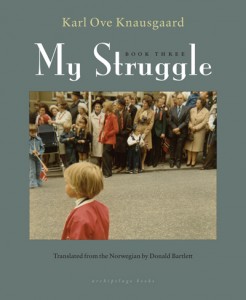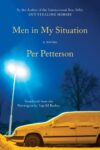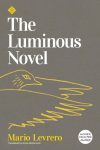
[Archipelago; 2014]
Tr. Don Bartlett
1.
The Norwegian novelist Karl Ove Knausgaard is this year’s Michel Houellebecq, this year’s Roberto Bolaño — the latest literary gunslinger from elsewhere who rides into town, kicks over the poker table, and says “I’ve got a new game we can play.”
His game is called “Telling the Truth,” and it’s less concerned with plumbing the depths of the imagination or forging an original literary voice (although he does both, to some degree) as it is with recovering the experience of actual living with as much intensity as possible.
The result is My Struggle, a six-volume work, written between the years 2009 and 2011, totaling some 3,700 pages and covering the sum total of Knausgaard’s life, which by the time he was finished, only amounted to 42 years. It’s an extraordinary act of ambition, ego, and some controversy — and not just because (for reasons that remain mysterious at this stage) it borrows its title from Hitler.
So far, three of the books have arrived in this country, skillfully translated (so it seems to me) into clear and concise English prose by Don Bartlett. The first book recounts both the author’s adolescence and the long decline and sad death of his abusive father. The second, A Man in Love, gives the story of his tumultuous marriage and career.
The just-published third volume, Boyhood, goes back and fills in the details of his early years and underscores just why the author had a considerable lack of feeling when his father finally came to ruin. It continues a remarkable narrative but also, closing in on the halfway mark, raises some fresh questions about the endurance of this particular enterprise — and whether, in the end, the self really is enough.
2.
For the benefit of readers who have not already wearied of reading about the author or seeing his penetrating, chiseled countenance peering out from book pages and webzines, perhaps a little back story is in order.
Prior to My Struggle, Knausgaard published two novels, Out of the World (1998) and A Time for Everything (2004), neither of which I’ve read but both of which were well received. The author himself, however, was meeting difficulty in moving forward as a novelist. As he describes it in the second volume of My Struggle, he had lost faith in fiction.
“The only genres I saw value in,” he writes, “which still conferred meaning, were diaries and essays, the types of literature that did not deal with narrative, that were not about anything but just consisted of a voice, the voice of your own personality, a life, a face, a gaze you could meet.” He was seized by a new idea: to “get as close as possible to my life.”
The result was a mad burst of energy that had him writing at a frantic but literate pace — not without its excesses and longueurs, but never less than alive. Even when it drags, the prose still has an active, throbbing pulse.
Part of the drive, certainly, is Knausgaard’s fearlessness, because he makes no pretense that he’s a particularly good or likable character with an adventurous life. He is instead a man with a very interior life, which he reproduces with all of its futility, contradictions, compromises, disappointments, and scattered joys. While it’s definitely relatable to the common experience of adult readers, universality is far from his aim. Rather, it’s to make his own life a unique prism into what life means, and to become, as Roger Shattuck once said of Marcel Proust, the artist of his own life.
When first published, My Struggle was a success almost in spite of itself in the author’s native country, where airing dirty linen and going into the details of family tragedies is considered bad form. As the American novelist Siri Hustvedt, who lived in Norway, told the New York Times, Norwegians were particularly shocked by Knausgaard’s story of his father.
“One of the few unwritten laws in that society,” she said, “is that revealing these kinds of things about a family is deeply shameful.”
Total honesty is Knausgaard’s guiding light; he uses real names and events, says what he really thinks about everyone he knows, draws pitiless psychological profiles of his closest friends, and sizes up the literary competition, possibly at the risk of getting disinvited to a few PEN International dinners. (He gave up on finishing Don DeLillo’s Underworld, he says, “and since the next book had been terrible it was evident he was in decline.”)
More than anyone else, he digs away relentlessly at his own thoroughly solitary self. He never shies away from his worst fears or fails to note his fakery, weakness, and selfishness in pursuit of his career (of which, arguably, the book offers considerable proof.)
“I never say what I really mean, what I really think,” he tells us early in the first book, “but always more or less agree with whomever I am talking to at the time, pretend that what they say is of interest to me, except when I am drinking, in which case more often than not I go too far the other way, and wake up the fear of having overstepped the mark.”
His aim is not masochism but self-awareness, even when risking the reader’s sympathy. Like Marcel Proust, his acknowledged master, he works from the interior outward. Every memory triggers another and becomes a clue to a bigger existential mystery. He breaks life down into particulars, creating a narrative that is a good deal more eventful than the life it records.
Telling the truth is nothing new, but telling it at this kind of length, with this kind of specificity, seems in some way to raise a challenge — to ask in the starkest way possible why writers turn to fiction to give shape to experience. Why create characters when your life is already full of them? Why create an alter ego when the real ego can do the work? Why use masks? Why create fake drama when all you have to do is remember it? Why not take that whole “write what you know” advice and drive it to the edge of the cliff?
3.
Casting himself as the protagonist in his own story gave Knausgaard not only a form, but a function, an artistic purpose: to dig away at what life means, particularly when weighed against the fact that time, for all of us, is running out.
Death is the book’s great inspiration; it’s what gives the writing such urgency, fluidity, and momentum. It’s there in the remarkable opening lines of the first volume.
For the heart, life is simple: it beats for as long as it can. Then it stops. Sooner or later, one day, this pounding action will cease of its own accord, and the blood will begin to run towards the body’s lowest point, where it will collect in a small pool, visible from the outside as a dark, soft patch on ever whitening skin, as the temperature sinks, the limbs stiffen and the intestines drain. These changes in the first hours occur so slowly and take place with such inexorability that there is something almost ritualistic about them, as though life capitulates according to specific rules, a kind of gentleman’s agreement to which the representatives of death also adhere, inasmuch as they always wait until life has retreated before they launch their invasion of the new landscape.
We don’t yet know what triggers these thoughts, which leads to a grim disquisition on society’s refusal to face death, but this preoccupation with mortality works for the narrator the way the madeleine dipped in tea worked for Proust in Swann’s Way — it brings everything back, setting Knausgaard on a personal journey that becomes both an exhaustive act of memory and a defense against being forgotten.
While death is the book’s motivator, consciousness keeps it going; facing death becomes a matter of facing life — which, for Knausgaard, begins with the mystery of faces.
He recalls himself at eight. He’s watching a televised news report of a rescue at sea, and thinks he sees the image of a face on the surface of the water. To him, this is deadly serious mystical business; to his father, it’s just another of his son’s childish whims, which he greets with the usual derision.
Fast-forward some thirty years: the grown-up novelist and his young family are living in an apartment in Malmö, Sweden. Faces are still on his mind, mainly because he’s looking at his own in the mirror. There’s something else weighing on him: he’s the same age his late father was when his parents separated, sending his father into a tailspin from which he never recovered.
After first detouring through a somewhat bland account of his early adolescence, Knausgaard delves deep into the memory of his father’s mid-life crisis, during which he leaves the family for another woman, becomes an alcoholic, gains weight, loses the woman, loses his job, and moves in with his mother, who is already suffering from dementia. Both become round-the-clock drinkers and let the house go to rack and ruin. Ultimately, the father suffers a fatal heart attack.
His father’s demise throws their relationship into sharp relief; mainly, Knausgaard’s absence of feeling for a father whose ridicule and abuse were always close at hand. Nonetheless, he resolves to hold a wake in his father’s house — a completely filthy hovel that he and his brother Yngve will have to clean.
What follows may be the most compelling scene about cleaning a house you’ll ever read, because it’s also about sifting through the wreckage of his father’s life. Pages upon pages are devoted to the fine details of mopping and dusting and spraying, using solvents, emptying ashtrays, carting off trash, picking up countless empty liquor bottles — all while his grandmother drifts further from rationality, staring out the window, making the same comments over and over. It’s as if the unseen interior of a corpse described in the first few pages has become externalized.
4.
Between the first and second volumes, Knausgaard details the beginning and end of his first marriage, to Tonje, and the start of his second, to Linda, with whom he has three children. A Man in Love is full of conflict, primarily between the inward and outward demands of being a writer and a husband and a father; the deep need for solidarity, the responsibility toward providing for a family, and the uneasiness with other people.
He has, always, an acute antennae for humiliation, guilt, or being put at some kind of social disadvantage — even when, say, he takes his young daughter to another child’s birthday party. Here he suddenly feels outclassed by the host, wondering if his own child measures up to the other kids, and he feels suffocated by all the other parents. He can’t wait to leave, but when he does, the feeling stays with him.
Was it the shrill, sickly tone I heard everywhere that I couldn’t stand, the one that arose from all the pseudo people and pseudo places, pseudo events and pseudo conflicts our lives passed through, that which we saw but did not participate in, and the distance that modern life in this way had opened up to our own, actually inalienable here and now? If so, if it was more reality, more involvement I longed for, surely it should be that which I was surrounded by that I should be embracing? And not, as was the case, longing to get away from?
The real question at the heart of it, though, is whether he’s a fraud. It’s never directly stated, but he is constantly putting himself through a Dostoevskian examination to determine which side of him is real. He details experiences to determine how they’ve shaped him, and what he has become.
5.
All this drilling, all this interior data-mining, must have left Knausgaard exhausted, and Boyhood arrives as something of a relief. He’s a kid again, growing up in a small town in Norway, where life is divided between the adventure of being outside and the terror of being at home, suffering under the reign of his dad.
Out of doors or in school, he’s all about exploring, like most kids: playing with matches, literally looking for gold at the end of the rainbow, putting his seven-year-old penis in a beer bottle (and getting stung by a beetle), and investigating the mystery of why some bowel movements are harder to expel than others. He takes to school with great ease, because he’s good at it; shopping for new school supplies is like Christmas Day.
It’s the time of life when he is most self-conscious of how people treat him, and least aware of his pride and insensitivity:
About me it was said that I always knew best and I was always boasting. But I did know best, I knew much more than the others, so why should I pretend anything else? If I knew something, it was because that was how it was.
It’s this same cocky self-assuredness that makes him cruel, such as when he drives an older boy to tears because he can’t read properly:
Of course, he does more than his own fair share of weeping. The great conflict at the heart of the book is between Karl Ove, the hyper-sensitive youth who cries at the drop of a hat, and the overbearing father who bullies him at every opportunity.
The father — a respected and ambitious schoolteacher — is a terror, constantly on red alert for any slight, any sign of disrespect, any hint that his son might be getting away with something, even when he isn’t. Any suspicion is reason enough for him to twist his son’s ear, slap him, send him to his room without supper, scream in his face — preferably when he’s already on the verge of tears — or come up with harsh (and often misguided) punishments. Losing a sock means losing his swimming privileges; eating one apple too many means being force-fed apples until he’s sick.
“His fury struck like a wave,” he writes, ”it washed through the rooms, lashed at me, lashed and lashed and lashed at me, and then it retreated.”
Like Kafka’s father, he rules by fear and paranoia, bringing fantasies of vengeance. Karl Ove dreams of killing his dad, or at least dying young and making his father eternally remorseful. You can’t help but be on the kid’s side: his dad is an asshole. Yet, there are times when Knausgaard is bent on showing that his father is more complex, and he occasionally tries to see himself through his father’s eyes.
There was my interest in clothes, my crying if I didn’t get the shoes I wanted, my crying if it was too cold when we were in the boat on the sea, indeed my crying if he raised his voice in situations when it would have been absolutely normal to raise your voice. Was it so strange he thought: what kind of son have I got here?
He’ll also drop little hints of paternal kindnesses or vulnerability — such as how ridiculous his father looked when he tried to ski.
I point all this out not to play devil’s advocate for the late Mr. Knausgaard — apparently his family is doing that with threats of lawsuits — but only to say that there seemed to be more to it than we’re getting.
In fact, it’s something of a surprise midway through the book to read that Karl Ove’s elder brother Yngve had it far worse. Knausgaard doesn’t explore this fact at all. He just says it and let’s it drop, maybe because his hermetically-sealed absorption wouldn’t permit it. Isn’t there more of a story there, that the father terrorized both his sons? The father-son relationship is compelling, but also one-sided, or perhaps fractured.
This, it can easily be argued in response, is the nature of memoir and especially this unique example of it. But it also underscores a fault with this book, especially noticeable if you read it a second time: it’s claustrophobic. Part of Knausgaard’s appeal is that his vision is so intensely self-directed, but the solipsistic grandeur begins to wear thin, as it prevents him from ever looking closely at anyone else — not just his father, but his brother, his mother, his friends. What’s the mother’s role in this tyranny? She only seems to drop in to say something kind or do something obliviously dense. (In one of the book’s best scenes, she buys Karl Ove a flower-bedecked girl’s swimming cap.) Karl Ove repeatedly tells us how much he loves and admires Yngve, but we never really get a full picture of him. And his friends barely distinguish themselves from each other, possibly because they’re all named Geir. (I counted at least four.)
It may sound a little churlish on my part to blame Knausgaard for upstaging everyone in what is, by design, a one-man show, but I kept thinking of Proust, and if maybe Knausgaard didn’t draw the wrong lesson from him.
For all his sleepless nights, Marcel was never about just himself. His great novel wasn’t just about the self; it was about embroidering a very huge nineteenth-century world, and anyone who has read Remembrance of Things Past at any length will have a memory of far more than just the narrator. There’s the story of Charles Swann and Odette de Crecy — the most heart-breaking love story ever written — Madame Verdurin, Marcel’s grandmother, Albertine, and Charlus, to name only the most obvious. These are some of the greatest flesh-and-blood characters in literature. When you look at the focus of Knausgaard in comparison, you wonder if all this narrow self-absorption isn’t a bit of a missed opportunity, if maybe the other people in his universe — and we as readers — would not be better-served if they were all liberated, which gets back to those questions I asked earlier about the modern relevance of fiction. Maybe the only way to do it would be to make this a real novel, and not just a memoir with novelistic scope.
But that, of course, is water under the bridge. If maybe we don’t have a great novel, we have at the halfway mark a roundabout sense of a writer’s life. Whether Knausgaard can deliver a grand summation, produce his own The Past Recaptured, in which all the pieces are knitted into an artistic whole, remains to be seen. But then, maybe he’s not trying to recapture the past. Maybe he’s just looking for fragments to shore up his ruins.
This post may contain affiliate links.







